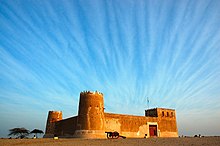Zubarah

Zubarah (also Al Zubarah or Az Zubarah) (Arabic: الزبارة) is a ruined and deserted town located in the northwestern coast of the Qatar peninsula about 105 km from the Qatari capital of Doha, part of Madinat ash Shamal municipality. It was also a fortified town with an inner and an outer wall.
History
Bani Utbah Tribe
Zubarah was originally the center of power of the Bani Utbah in which the Al Bin Ali Tribe in Bahrain, Qatar, Kuwait, Saudi Arabia, and U.A.E derives from. The Al Bin Ali Tribe are the original descendants of Bani Utbah tribe being that they are the only tribe to carry the last name Al-Utbi in their Ownership's documents of Palm gardens in Bahrain as early as the year 1699 - 1111 Hijri [1] . They are specifically descendants of their great grand father Ali Al-Utbi who is a descendant of their great grand father Utbah hence the name Bani Utbah which means sons of Utbah. Utbah is the great grandfather of the Bani Utbah which is a section of Khafaf from Bani Sulaim bin Mansoor from Mudhar from Adnan.The plural word for Al-Utbi is Utub and the name of the tribe is Bani Utbah.
Al Bin Ali
The Al Bin Ali were a politically important group that moved backwards and forwards between Qatar and Bahrain, they were the original dominant group of Zubara area [2]. The Al Bin Ali were known for their courage, persistence, and abundant wealth [3]. The Al Bin Ali were also known historical wise as being a practically independent community in Bahrain since they are not forced to pay any sort of taxes by the Rulers of Bahrain Al Khalifa, therefore they were self-governed.

The Al Bin Ali, settled at Zubarah in the first half of the eighteenth century and established the town of Zubarah and its port making it one of the most important port and pearl trading centers in the Persian Gulf in the 18th Century. The Al Bin Ali also built a fort outside the town of Zubarah and named it Murair.
The name Murair, was originally the name of a water spring in the Bani Sulaim area next to Madina Al Munawara in today's Saudi Arabia also known as Herat Bani Sulaim.
The Original Utub Al Bin Ali conquered and expelled the Persians from Bahrain [4] after defeating them in the battle of Zubarah that took place in the year 1782 between the Al Bin Ali and the Army of Nasr Al-Madhkur Ruler of Bahrain and Bushire. It is well know that the strategist of this battle was Shaikh Nasr Al-Madhkur, his sword fell into the hands of Salama Bin Saif Al Bin Ali after his army collapsed and his forces were defeated [5]. The Al Bin Ali, have kept the sword with them and they kept passing it from son to grandson until it was given as a gift to King Abdul Aziz Bin Faisal Al Saud and it can be seen today at the King AbdulAziz Museum in Riyadh, Capital of Saudi Arabia.
20th and 21st century
In the 20th century by July 1937, Zubarah, by then largely in ruins, was taken by the Qatari Al Thani family and remained a possession of Qatar after independence in 1971. Bahrain continued to dispute Qatari sovereignty over Zubarah until the issue of Zubarah was settled to Qatar's side due to the lack of evidence that the Al-Khalifa Rulers of Bahrain have established this town originally, other territorial issues have also been settled to Bahrain's side such as the Hawar Islands by the International Court of Justice in 2001. For more, see Foreign relations of Qatar.

Zubarah Fort
Zubarah is noted for its old fortress built in 1938 under orders of Qatari Sheikh 'Abdu'llah bin Qasim Al-Thani and restored in 1987 as a museum. It is different from the Murair fort that was built outside the town of Zubarah.
Bahrain - Qatar Friendship Bridge
The planned Qatar–Bahrain Friendship Bridge, slated to be the longest fixed link in the world, will connect the northwest coast of Qatar near Zubarah with Bahrain south of Manama.
See also
- Al Bin Ali
- History of Kuwait: The Anazia and Bani Utub (Early Migration and Settlement)
- Bani Utbah
- Murair
- Zubarah
- 1783 Bani Utbah Liberation of Bahrain
- Fort Jesus
- History of Qatar
- History of Bahrain
- Ahmed Al-Fateh
- Al-Sulami flag
References
- ^ Ownership's Document of a Palm Garden in Island of Sitra, Bahrain belonging to Shaikh Salama Bin Saif in which the owner carries the Al-Utbi last name dated 1699 - 1111 Hijri, http://www.albdoo.info/imgcache2008/3af882fe7cb2511eb935435895e1a566.gif , also Ownership's Document of a Palm Garden in Island of Nabih Saleh, Bahrain belonging to Shaikh Mohamed Bin Derbas in which the owner carries the Al-Utbi last name dated 1804 - 1219 Hijri, http://www.albdoo.info/imgcache2008/641cb18bbd2aae86c67ac578e2c1670a.jpg , also in the Precis Of Turkish Expansion On The Arab Littoral Of The Persian Gulf And Hasa And Katif Affairs. By J. A. Saldana; 1904, I.o. R R/15/1/724, assertion by British Foreign Secretary Of State in 1871 that Isa Bin Tarif belongs to the Original Uttoobee's who conquered Bahrain, which means that he differentiate's the Original Uttoobee's who's desendants are the Al Bin Ali since they are the oldest and only tribe who officially carried the Al-Utbi last name in their ownership's documents, from the Utubi's who entered under its umbrella such as the Al-Khalifa and Al-Sabah and other families
- ^ Arabia's Frontiers: The Story of Britain's Boundary Drawing in the Desert, John C. Wilkinson, p44
- ^ Arabian Studies By R.B. Serjeant, R.L. Bidwell, p67
- ^ the Precis Of Turkish Expansion On The Arab Littoral Of The Persian Gulf And Hasa And Katif Affairs. By J. A. Saldana; 1904, I.o. R R/15/1/724
- ^ Shaikh Hamad Bin Isa Al-Khalifa ,First Light: Modern Bahrain and its Heritage, 1994 p41
